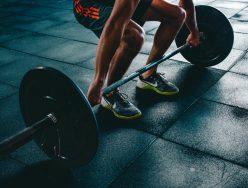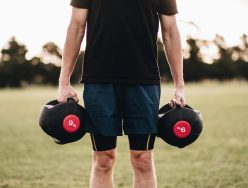Foremost, how vital is proper push-up progression?
As I have written happily time after time — most clients can benefit from properly progressing their push-up because appropriate push-up progression provides: core stabilization, improved posture, increased power, extra endurance, stronger stability in your joints, more strength in their upper and lower body, increased muscle mass, and fat loss.
Additionally, mastering push-ups in terms of Stabilization, then Strength, to then graduate to Power is fundamental in achieving optimal core stabilization and movement muscles while building lean muscle by engaging the correct muscles. These phases cannot be skipped and shouldn’t be progress until each phase is truly mastered especially while using any equipment. In other words, a client should first progress accordingly using their own body weight before the usage of a Bosu, stability ball or another piece of equipment.
When your clients have mastered efficient Stabilization, their strength progressions can flourish. Strength push-up exercises engage more of the core movement muscles than the core stabilization muscles because your clients are in motion. Strength movements provide a double functional and aesthetic hit to their core since they engage both groups of core muscles. Push-ups in the Strength phase can obviously promote strength, however, your clients will obtain hypertrophy, too.
The X push-up provides a different challenge than the Traditional Push-up in the Strength Phase because your clients will be executing movement with their arms. Performing push-ups with hand movements, while their legs are stable, is much more challenging than performing push-up exercises while their arms are stable with leg movements. This is due to the core stabilization and movement muscles correctly engaging to perform the exercise for optimal efficiency. The X Push-up is a nice challenge to introduce arm movements to your clients’ push-up progression program due to their lower body moving with their upper body. The “X” movement of this push-up will add extra stability for the core and make this portion of the push-up easier to perform while engaging their hip abductors. However, the constant movement in their upper and lower body will be a great test for their core movement muscles. This push-up builds lean muscle in the primary movers such as the anterior and medial deltoid muscles, pectoralis major and pectoralis minor muscles, triceps, and all three of your gluteal muscles. Your clients’ latissimus dorsi muscles and scapulae provide extra stability during this exercise.
Starting position: Have your clients begin with their hands and feet positioned two steps wider than your traditional push-up position. This creates the “X” that their upper and lower body will be forming throughout this push-up exercise.
To Perform: Your clients will lower themselves downward into a push-up with their elbows bent at 90-degrees with their nose gently touching the floor. Then, they should rise up back into the starting position and bring their knees, legs, and feet together. Next, have them move their hands inward to shoulder-width apart as they execute another push-up with their elbows bent at 45-degrees, with their nose gently touching the floor. Continue to have them move their upper and lower body back into the “X” position and perform a push-up while moving their upper and lower body back into the close position with their knees, legs, and feet together. Develop a consistent tempo or speed in completing these two push-up movements. The optimal goal is to have their nose touch the floor for both of these push-ups for optimal range of motion.




Beginner: Three sets total, one set equals performing both push-ups for 10 repetitions
Intermediate: Four sets total, one set equals performing both push-ups for 16 repetitions
Advanced: Four sets total, one set equals performing both push-ups for 24 repetitions
Rest time between sets should be two to three minutes for recovery.
Coaching Tips: Remember to have your clients stay controlled during this exercise, especially when it comes to moving their arms, and have them place their hands down gently on the floor throughout. It’s vital to keep the neutral spinal position throughout since both their upper and lower body are in motion to avoid any lower back strain in the erector spinae. The X portion of this push-up should feel easier than the second portion of this exercise due to less core stability needed to perform the push-up. Although, if this exercise proves to be too difficult, position their hands greater than shoulder-width apart with their knees, legs, and feet together during the second portion of this push-up for added stability. Their hands should never rotate inward during either of the push-up portions of this exercise. Remember to have them use their palms, not their wrists, for added stability when executing these push-ups.
Was this Article Helpful?
If this article was helpful to you, please consider linking this article to your own blog or sharing this through the social buttons below. You will also find other great articles at “Ask An Expert“.
- 5shares
- 2Facebook
- 3Twitter
- 0Pinterest
- 0LinkedIn
Shaun Zetlin
For over ten years, Shaun has successfully run his own personal training business in the New York City Metro area. Able to relate and adapt to each individual, Shaun prides himself on developing exercise plans and nutritional menus to foster every client's fitness needs. His clientele ranges from the athlete, and senior citizen, to bodybuilder, and dancer. Shaun's specialties include: strength training, power techniques, corrective injury training, and core stability training.
In addition to the highly regarded Master Trainer status, Shaun is a certified personal trainer of the National Academy of Sports Medicine (NASM). With NASM Shaun also holds specialized certifications in: Pre- and Post-Natal, Corrective Exercise Practices, Cardiovascular Weight Loss, Youth Training, Senior Citizen Training, Balance Training, Core Stabilization, and Self Myofascial Release (SMR). Additionally, Shaun is certified by the International Sports Sciences Association (ISSA) as a Strength and Conditioning Specialist and Sports Performance Nutrition Specialist, with training in the Female Athlete, Knee & Shoulder Rehabilitation, and Marathon Training. Shaun earned his Bachelors degree in English Literature and Writing from the University of Delaware.
Shaun's first full-length book, "Push-up Progression Workout for a Stronger Core" is currently available worldwide both in paperback and e-book formats. It was featured as one of three top books in 2013 for healthy living as selected by Dr. John Whyte of The Discovery Channel. His latest book, "Push-up Progression (2nd Edition)" has already achieved great success and notoriety in the world of fitness. It is currently featured in bookstores across the United States and United Kingdom in paperback and available wherever e-books are sold. Shaun has had a multitude of articles, program designs, and tips published within a variety of books, magazines, and on websites in the world of fitness and beyond including: Price World Publishing, Demos Medical Publishing, Livestrong, Rodale Books, OnFitness Magazine, Fitness Magazine, Brides Magazine, and GO: AirTran Magazine. Additionally, Fitness Professional Online recognizes Shaun as an "expert," answering questions for other fitness and health professionals.
Shaun also has media experience in both television and radio, ranging from fitness modeling, to hosting his own weekly radio fitness show.
Latest posts by Shaun Zetlin
- The Role of Exercise in Stress Management - May 9, 2017
- X-Push Up - December 27, 2016
- Fit Pros, How To Properly Progress Your Client’s Push-Up? - October 26, 2016


















